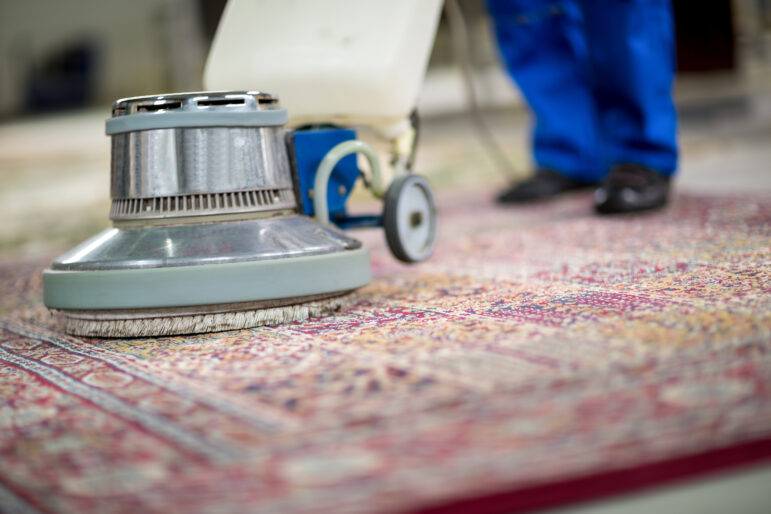As labour continues to be a challenge, budgets get smaller, and remote work persists, commercial carpet cleaning may be left to the discretion of businesses to manage. Often not included in standard housekeeping service charges, carpet cleaning may be categorized as an extra service that’s billed separately.
This can mean that the carpets become neglected, getting attention only during certain times of the year, when spills occur, or as a sporadic addition to scheduled cleaning. Carpets play a key role in air filtration, capturing dust, allergens, and other pollutants. When carpets are not regularly cleaned, they can no longer perform this function effectively. As a result, these contaminants accumulate until they disperse into the ambient air, affecting air quality throughout the building.
Health concerns
Several studies highlight the importance of regular carpet cleaning in improving indoor air quality and the health of building occupants. In addition, the Carpet and Rug Institute provides a variety of resources and studies that examine the impact of carpet care on various aspects such as air quality, health, and sustainability. Their website offers a comprehensive overview of this research, including case studies and detailed analyses of the effectiveness of carpet cleaning and other flooring materials indoors.
An in-depth study carried out at the Frank Porter Graham Child Development Center reveals the considerable positive impact of extraction carpet cleaning on indoor air quality. Prior to the implementation of a rigorous cleaning program, the average concentration of total suspended particulates (TSP) in the building was 11 ug/m³. Following the adoption of a thorough annual cleaning program, this concentration dropped to an average of 5.7 ug/m³, an impressive 52 per cent improvement. In addition, the average concentration of total volatile organic compounds (TVOC) was reduced by 49 per cent, from 324 ug/m³ to 165.7 ug/m³. The study also showed a 40 per cent reduction in airborne bacteria and a 61 per cent reduction in airborne fungi. These results underline the effectiveness of extraction cleaning, not only to keep carpets in good condition but also to provide a healthier indoor environment.
Carpets act as air filters to minimize the dispersion of dust and allergens in the air. If they are not vacuumed regularly, the contaminants accumulated are released back into the air and can spread to other parts of the building, affecting air quality and the health of occupants in other rental spaces. This deterioration in air quality can lead to an increase in allergy symptoms and respiratory problems among employees and visitors, directly affecting productivity and well-being at work. One case study showed that diligent carpet cleaning can reduce airborne allergens by 40-80 per cent. In addition, other laboratory studies with advanced cleaners have shown that deep carpet cleaning, combined with an efficient heating, ventilation, and air-conditioning (HVAC) system, can reduce allergens by up to 99 per cent.
The effect on cleaning staff
In a context of labour shortages and high turnover in the housekeeping industry, inadequate carpet maintenance can not only increase overall maintenance costs, but also pose additional service delivery challenges. Lack of regular carpet care leads to increased accumulation of dust, dirt, and allergens, which in turn requires more frequent and intensive cleaning of other building surfaces and spaces.
The cleaning teams, already under pressure due to high workloads and limited resources, must put in extra time and effort to maintain the expected level of cleanliness. If good carpet care techniques are not practised regularly or properly instructed to on-site teams, the high turnover rate directly affects the quality of cleaning throughout the building.
Higher operating costs
While a regular carpet cleaning strategy can include additional equipment and cleaning products, and potentially hiring more staff to manage the increased workload, it outweighs the cost of replacing carpets when poor maintenance leads to premature wear and tear. These costs can add up quickly, affecting the overall building management budget.
Wear and tear on ventilation systems
Particles and pollutants escaping from unmaintained carpets are eventually absorbed by the building’s ventilation systems. This can overload filters and reduce the overall efficiency of the ventilation system. The accumulation of dust and debris in ventilation filters requires more frequent maintenance and replacement, increasing maintenance costs for facility and maintenance managers.
RELATED: Extending the life of your commercial carpets
Quality carpet cleaning in building maintenance contracts is not only beneficial for maintaining visual cleanliness but is also essential in protecting the air quality and health of all building occupants. This helps to increase tenant satisfaction by ensuring a healthier work environment while minimizing negative effects on ventilation systems and overall maintenance costs.
Facility and maintenance managers need to ensure that carpet cleaning is part of their commercial cleaning contract to maintain an overall professional look, increase sanitization and wellness practices, and save money over the long term on equipment repair and replacement.
Karl Bédard is the Senior Director at ValkarTech, a consulting firm dedicated to optimizing commercial cleaning contracts. As an experienced LEED Green Associates certified auditor, he conducts many building visits and evaluates customers’ various processes. His recommendations are always aimed at improving cleaning quality and productivity while minimizing costs.









